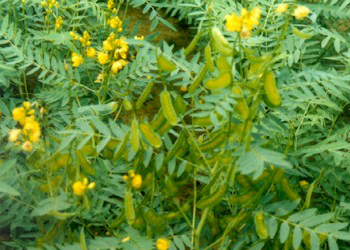
Senna alexandrina |
 |
Patel, M., M. O. Schimpf, D. M. O’Sullivan and C. A. LaSala. 2010. The use of senna withdocusate for postoperative constipation after pelvic reconstructive surgery: a randomized, double-blind, placebo-controlled trial. American Journal of Obstetrics and Gynecology 202, 5: 479.e1-479.e5 Objective: The objective of the study was to compare time to first bowel movement (BM) after surgery in subjects randomized to placebo or senna with docusate. Study Design: Ninety-six subjects completed a baseline 7-day bowel diary before and after surgery. After pelvic reconstructive surgery, the subjects were randomized to either placebo (n = 45) or senna (8.6 mg) with docusate (50 mg) (n = 48). Time to first BM and postoperative use of magnesium citrate were compared. Results: There was a significant difference in the time to first BM in those receiving senna with docusate vs placebo (3.00 ± 1.50 vs 4.05 ± 1.50 days; P < .002). More subjects in the placebo group needed to use magnesium citrate to initiate a bowel movement (43.6% vs 7.0%; P < .001). Conclusion: The use of senna with docusate decreases time to first BM in those undergoing pelvic reconstructive surgery compared with placebo. Subjects using senna with docusate are also significantly less likely to use magnesium citrate. ............................................................................................................ WHO monograph on selected medicinal plants volume I. 1999. World Health Organization, Geneva. Clinical Pharmacology; The time of action of Senna is usually 8–10 hours, and thus the dose should be taken at night. The action of the sennosides augments, without disrupting, the response to the physiological stimuli of food and physical activity. The sennosides abolish the severe constipation of patients suffering from severe irritable bowel syndrome . In therapeutic doses, the sennosides do not disrupt the usual pattern of defecation times and markedly soften stools. Sennosides significantly increase the rate of colonic transit and increase colonic peristalsis, which in turn increases both faecal weight and dry bacterial mass. Due to their colonic specificity, the sennosides are poorly absorbed in the upper gastrointestinal tract. ................................................................................................... Kenny, S. E., T. Irvine, C. P. Driver, A. T. Nunn, P. D. Losty, M. O. Jones, R. R. Turnock, G. L. Lamont and D. A. Lloyd. 2001. Double blind randomised controlled trial of topical glyceryl trinitrate in anal fissure.Arch Dis Child 85: 404–407. Abstract Aims—To determine the effectiveness and safety of topical glyceryl trinitrate (GTN) in the management of acute anal fissure in children. Methods—Individual children were randomised to receive GTN paste or placebo for six weeks in addition to oral senna and lactulose.Patients took laxatives alone for a further 10 weeks. Each week a research nurse telephoned families to assess pain scores and give advice. Main outcome measures were validated standardised pain scores and time to painless defaecation. Results—Forty subjects were recruited from 46 eligible children; 31 children completed the trial (13 in the GTN group and 18 in the placebo group). No differences in the proportion of those achieving pain free defaecation with relation to time were seen between the two groups. Similarly, there were no significant differences in pain scores between the two groups over the 16 week study period. However, in both groups pain scores had decreased significantly. There were no differences in the incidence of rectal bleeding, faecal soiling, presence of visible fissure, skin tag, or faecal loading at outpatient review at the time of recruitment, or at 6 weeks and 16 weeks. No serious adverse effects were observed. Conclusions—This study suggests that 0.2% GTN paste is ineffective in the treatment of acute anal fissures in childhood. However the overall fissure healing rate is high (84%) with associated reduction in pain scores, suggesting that a nurse based treatment programme can achieve a high rate of fissure healing. |
| กลับหน้าหลักสมุนไพร |
